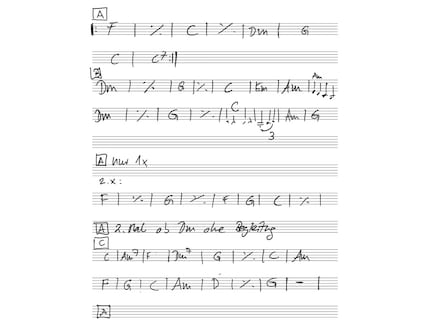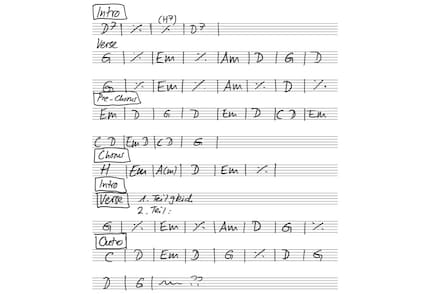
Background information
The Tsunami of AI music: more is definitely not better
by David Lee

From crazy Smurfs, stolen song titles and generic Beatles songs: an experiment to see if and how I can get creative with the music generator Suno.
Generative artificial intelligence has recently become available for music in acceptable quality. Some of the pieces of music that Suno version 3 generates at the touch of a button are astonishingly good.
This naturally brings a lot of uncertainty for the future. Many discussions revolve around the question of whether creative work will become superfluous and no longer paid. But for me as a hobby musician, a much more banal question arises: what is the point of such a tool? Can I use it in any meaningful way for my hobby?
You enter the instructions for what Suno has to do as free text - a so-called prompt. My knowledge of music theory or instruments is of no use to me. If I enter details such as the key in the description, Suno ignores them. For example, I wanted Suno to play a piece in B flat major. I got two in E major. Instead of a rock ballad in D minor, I got a piece in E minor and one in A minor.
Another example: I request a slow blues with 60 beats per minute. Suno creates two pieces that are not really blues pieces, one at 54 beats per minute and one at 78 beats per minute.
It's very similar to the tools that generate an image from text. The AI does something rather random, not what you have in mind. Precise instructions such as key or tempo do not change this.
You can enter meta tags in square brackets in Suno. This allows you to specify a certain song structure, for example an intro, three verses and the chorus each time. More specific information is also possible for the individual parts, such as that the verse should be rapped. Ultimately, however, this doesn't change the fact that the end result is not what I had in mind. The website also states the following on the topic of meta tags: "Even when they work, they don't always work. When they do work, it can still feel like a casino." In other words: Even when they work, they don't always work. When they do work, it can still feel like a casino.
I can confirm this with an example. I give the following structure:
Funk
[intro drums only]
[melodic chorus]
[rapped verse]
[chorus]
[verse]
[outro similar to chorus]
And then get this:
There is simply no chorus (refrain), and my drum intro is also omitted. The outro anyway. The verses are not rapped, but sung. Actually, Suno doesn't give a shit about my specifications, I could have saved myself the meta tags.
In short: Generative AI tools like Suno don't work the way I want them to. I want them to support me in my creative process, not take it over completely. But Suno does all the work for me, leaving me with nothing.
I think it's generally a good thing when machines take over tedious, arduous work. But this is the opposite. Why should the software do exactly what I enjoy doing the most? I'm not going to tell an AI tool to take a dip in the hot tub for me and watch my favourite films.
But perhaps Suno is a good source of ideas and inspiration. Maybe he'll spit out something that will give me new ideas.
My first idea is to create something with a high nerd factor. I instruct Suno to create a chiptune. The first two attempts are nothing, but I'm quite happy with the third and the fifth.
I decide to analyse one of the two songs in more detail and "make something of it" - I don't know exactly what that means at the time. It's the song in the video below. It's certainly not everyone's cup of tea in terms of style - Suno has probably confused chiptune with chipmunk here. Comment from colleague Martin Jud: "A good song for torture." But the composition convinces me. The song has an interesting structure.
First I want to understand the song and write out the structure and the chords.
The song has a total of eight chords. That's quite a lot. The majority of chart songs get by with half that. Often even in the exact same order.
The song also has a solid structure: three parts, one of which is repeated. This part is effectively the verse, albeit with slight variations. In an instrumental, every verse would sound the same, so the variations are a good tool. All parts of the song have 8 or 16 bars, which has a harmonious effect.

A special feature in the third part at 1:37 is a D major instead of a D minor chord, which adds to the already over-the-top cheerfulness. Also interesting: the interruption of the rhythm with quarter triplets at around 40 seconds.
I left out the short, confused intro in the analysis. I couldn't play that either.
First I record the chords - much slower than in Suno's piece - and try to do something original with them. But as I don't have a plan for what I want it to be, it sounds too arbitrary and I stop the exercise
Most of all, it seems to me that it's the melody that makes the song. It's not easy to find a good melody that you haven't heard a thousand times before. Suno has obviously succeeded here.
I decide to simply cover the song. Without the confusing intro, of course, and a little slower. And the voice shouldn't sound like the Smurfs have been put through a blender. I have something ska-like in mind.
For the fact that I'm not at all familiar with this style of music, I don't think it's bad at all. But I'm not satisfied with the result. I like the original better. I've taken the cute cheerfulness out of the piece and now it's just a well-hung beer tent jumble.
No general conclusions can be drawn from this one experiment. So I'm starting a second one. This time, too, I want Suno to produce something that doesn't sound like a mainstream sound. Because what's in the charts these days is extremely well produced, but in terms of the song idea, it's usually not the yellow of the egg.
Suno is supposed to generate a rock'n'roll number in the style of the fifties. And it doesn't. Instead, I get a song that sounds a lot like the Beatles in their phase around 1963/64. The Beatles also played a lot of classic rock'n'roll, but this doesn't belong in that category. Suno chose "Shake, Rattle and Roll" as the song title. That sounds a lot like rock'n'roll. So much so that there is already a well-known song with this title.
The song consists of five parts: Intro, verse, pre-chorus, chorus and ending. The ending breaks off in the middle. The pieces generated by Suno are usually two minutes long, but the tool doesn't always manage to make the piece exactly that long. The verse, which is only repeated once, varies slightly the second time round. This gives the song an interesting and meaningful structure.

I enjoy replaying this more than the first piece. Stylistically, it's more familiar to me and I mainly record instruments that I can actually play. This also allows me to interpret the song a little more freely. For the ska chiptune, I had to simulate an accordion on a keyboard, but I can't even play the keyboard properly.
I replaced the stalled ending with my own, much simpler one. I slow down the tempo so that it doesn't sound so robotic.
As the song title "Shake, Rattle and Roll" is stolen and doesn't fit the style, I change it to "Can't Steal Me Love". That's the subtle difference between stealing and parodying.
This time I'm happy with the result. But the process wasn't particularly creative.
Tools like Suno are useless for realising specific creative ideas. However, if I don't have a plan and need some inspiration first, Suno can be helpful. I can generate pieces and use them as a starting point for my own pieces that I play myself.
This is interesting as an experiment, but boring in the long run. And also somewhat questionable.
Firstly, tracks by real artists simply sound better. The sound quality is much better, the tracks don't break off in the middle and are sometimes longer than two minutes. Some are also really original - even if, admittedly, there are tonnes of boring songs that could just as easily have been written by an AI.
On the other hand, I like to emulate my role models. As an amateur musician, when I steal something (from a human), I do it to expand my musical repertoire and skills. Suno is not a role model, but merely an imitator himself. If I'm going to steal, I'd rather steal from the original.
Tools like Suno will flood the world with masses of "more of the same". That's not creative. It may devalue the original creative work without which these tools would not be possible. The longer I think about it, the more it annoys me, not upsets me. I've had enough of Suno, at least for now.
My interest in IT and writing landed me in tech journalism early on (2000). I want to know how we can use technology without being used. Outside of the office, I’m a keen musician who makes up for lacking talent with excessive enthusiasm.
Interesting facts about products, behind-the-scenes looks at manufacturers and deep-dives on interesting people.
Show all